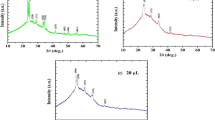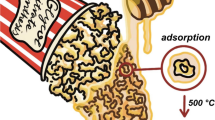Abstract
A new rapid and energy saving method for the obtention of high performance nanoparticles and thin films of Nb2O5 by microwave-assisted hydrothermal synthesis is reported. The hydrothermal treatment of a sol–gel precursor solution in a microwave oven at 180 °C for 20 min was enough to obtain amorphous nanoparticles with average sizes of 40 nm. The calcination promotes the formation of different phases of Nb2O5 (TT and T) with pseudohexagonal and orthorhombic structure, respectively, that transform at higher temperatures in a mixture of orthorhombic and monoclinic phases. Crystalline phase composition was found to have a significant influence on the photocatalytic activity. The best photocatalytic performance was observed for the material mainly constituted by the TT-Nb2O5 phase. Thin films constituted by the TT phase were prepared by dip-coating. Photocatalytic experiments confirmed the high photocatalytic activity of this material, which showed a kinetic curve similar to that of a reference TiO2-P25 thin film.








Similar content being viewed by others
References
B. Liu, H. Wang, Y. Chen, J. Wang, L. Peng, and L. Li: Pt nanoparticles anchored on Nb2O5 and carbon fibers as an enhanced performance catalyst for methanol oxidation. J. Alloys Compd. 682, 584 (2016).
M.A. Aegerter: Sol–gel niobium pentoxide: A promising material for electrochromic coatings, batteries, nanocrystalline solar cells and catalysis. Sol. Energy Mater. Sol. Cells 68, 401 (2001).
M. Lübke, A. Sumboja, I.D. Johnson, D.J.L. Brett, P.R. Shearing, Z. Liu, and J.A. Darr: High power nano-Nb2O5 negative electrodes for lithium-ion batteries. Electrochim. Acta 192, 363 (2016).
H.K. Kim, D. Mhamane, M.S. Kim, H.K. Roh, V. Aravindan, S. Madhavi, K.C. Roh, and K.B. Kim: TiO2-reduced graphene oxide nanocomposites by microwave-assisted forced hydrolysis as excellent insertion anode for Li-ion battery and capacitor. J. Power Sources 327, 171 (2016).
T.Y. Cho, K.W. Ko, S.G. Yoon, S.S. Sekhon, M.G. Kang, Y.S. Hong, and C.H. Han: Efficiency enhancement of flexible dye-sensitized solar cell with sol–gel formed Nb2O5 blocking layer. Curr. Appl. Phys. 13(7), 1391 (2013).
Z. Shen, G. Wang, H. Tian, J. Sunarso, L. Liu, J. Liu, and S. Liu: Bi-layer photoanode films of hierarchical carbon-doped brookite-rutile TiO2 composite and anatase TiO2 beads for efficient dye-sensitized solar cells. Electrochim. Acta 216, 429 (2016).
S. Ueno and S. Fujihara: Effect of an Nb2O5 nanolayer coating on ZnO electrodes in dye-sensitized solar cells. Electrochim. Acta 56(7), 2906 (2011).
G.S. Chao Liang, Z. Wu, P. Li, J. Fan, and Y. Zhang: Chemical bath deposited rutile TiO2 compact layer toward efficient planar heterojunction perovskite solar cells. Appl. Surf. Sci. 391, 2 (2016).
C. Belver, J. Bedia, and J.J. Rodriguez: Zr-doped TiO2 supported on delaminated clay materials for solar photocatalytic treatment of emerging pollutants. J. Hazard. Mater. 322, 233 (2015).
O.F. Lopes, E.C. Paris, and C. Ribeiro: Synthesis of Nb2O5 nanoparticles through the oxidant peroxide method applied to organic pollutant photodegradation: A mechanistic study. Appl. Catal., B 144, 800 (2014).
C. Karunakaran, R. Dhanalakshmi, P. Gomathisankar, and G. Manikandan: Enhanced phenol-photodegradation by particulate semiconductor mixtures: Interparticle electron-jump. J. Hazard. Mater. 176, 799 (2010).
M.P.F. Graca, A. Meireles, C. Nico, and M.A. Valente: Nb2O5 nanosize powders prepared by sol–gel—Structure, morphology and dielectric properties. J. Alloys Compd. 553, 177 (2013).
M. Ziolek: Niobium-containing catalysts—The state of the art. Catal. Today 78(1–4), 47 (2003).
Z. Yue, A. Liu, C. Zhang, J. Huang, M. Zhu, Y. Du, and P. Yang: Noble-metal-free hetero-structural CdS/Nb2O5/N-doped-graphene ternary photocatalytic system as visible-light-driven photocatalyst for hydrogen evolution. Appl. Catal., B 201, 202 (2017).
F. Hashemzadeh, R. Rahimi, and A. Ghaffarinejad: Mesoporous nanostructures of Nb2O5 obtained by an EISA route for the treatment of malachite green dye-contaminated aqueous solution under UV and visible light irradiation. Ceram. Int. 40(7), 9817 (2014).
L.C.A. Oliveira, H.S. Oliveira, G. Mayrink, H.S. Mansur, A.A.P. Mansur, and R.L. Moreira: One-pot synthesis of CdS@Nb2O5 core–shell nanostructures with enhanced photocatalytic activity. Appl. Catal., B 152–153(1), 403 (2014).
H. Jiang, Y. Liu, S. Zang, J. Li, and H. Wang: Microwave-assisted hydrothermal synthesis of Nd, N, and P tri-doped TiO2 from TiCl4 hydrolysis and synergetic mechanism for enhanced photoactivity under simulated sunlight irradiation. Mater. Sci. Semicond. Process. 40, 822 (2015).
S.M. Lam, J.C. Sin, I. Satoshi, A.Z. Abdullah, and A.R. Mohamed: Enhanced sunlight photocatalytic performance over Nb2O5/ZnO nanorod composites and the mechanism study. Appl. Catal., A 471, 126 (2014).
G. Falk, M. Borlaf, T. Bendo, A.P. Novaes de Oliveira, J.B. Rodrigues Neto, and R. Moreno: Colloidal sol–gel synthesis and photocatalytic activity of nanoparticulate Nb2O5 sols. J. Am. Ceram. Soc. 99(6), 1968 (2016).
C. Tang, L. Liu, Y. Li, and Z. Bian: Aerosol spray assisted assembly of TiO2 mesocrystals into hierarchical hollow microspheres with enhanced photocatalytic performance. Appl. Catal., B 201, 41 (2017).
A. Mirzaei and G. Neri: Microwave-assisted synthesis of metal oxide nanostructures for gas sensing application: A review. Sens. Actuators, B 237, 749 (2016).
X.H. Zhu and Q.M. Hang: Microscopical and physical characterization of microwave and microwave-hydrothermal synthesis products. Micron 44(1), 21 (2013).
L.Y. Meng, B. Wang, M.G. Ma, and K.L. Lin: The progress of microwave-assisted hydrothermal method in the synthesis of functional nanomaterials. Mater. Today Chem. 1–2, 63 (2016).
M. Bhattacharya and T. Basak: A review on the susceptor assisted microwave processing of materials. Energy 97, 306 (2016).
H. Lin and C. Shih: Chemical efficient one-pot microwave-assisted hydrothermal synthesis of M (M = Cr, Ni, Cu, Nb) and nitrogen co-doped TiO2 for hydrogen production by photocatalytic water splitting. J. Mol. Catal. A: Chem. 411, 128 (2016).
H. Yang, H. Xu, L. Wang, L. Zhang, Y. Huang, and X. Hu: Microwave-assisted rapid synthesis of self-assembled T-Nb2O5 nanowires for high-energy hybrid supercapacitors. Chem.–Eur. J. doi: https://doi.org/10.1002/chem.201700010.
J. Tauc: Absorption edge and internal electric fields in amorphous semiconductors. Mater. Res. Bull. 5(4), 721 (1970).
C. Valencia-Balvín, S. Pérez-Walton, G.M. Dalpian, and J.M. Osorio-Guillén: First-principles equation of state and phase stability of niobium pentoxide. Comput. Mater. Sci. 81, 133 (2014).
L.K.S. Herval, D. Von Dreifus, A.C. Rabelo, A.D. Rodrigues, E.C. Pereira, Y.G. Gobato, A.J.A. de Oliveira, and M.P.F. Godoy: The role of defects on the structural and magnetic properties of Nb2O5. J. Alloys Compd. 653, 358 (2015).
J.M. Jehng and I.E. Wachs: Structural chemistry and raman spectra of niobium oxides. Chem. Mater. 3(1), 100 (1991).
T. Ikeya and M. Senna: Change in the structure of niobium pentoxide due to mechanical and thermal treatments. J. Non-Cryst. Solids 105(3), 243 (1988).
C. Nico, M.R.N. Soares, J. Rodrigues, M. Matos, R. Monteiro, M.P.F. Graça, M.A. Valente, F.M. Costa, and T. Monteiro: Sintered NbO powders for electronic device applications. J. Phys. Chem. C 115, 4879 (2011).
ACKNOWLEDGMENTS
This work was supported by Ministerio de Economía y Competitividad (Government of Spain) and FEDER Funds under the Grant no. MAT2015-67586-C3-2-R and CTM2015-69246-R. The authors thank the resources provided by CAPES under the International Cooperation Program Science without Borders for Special Guest Researcher, PVE (MEC/MCTI/CAPES/CNPQ/FAP/71/2013), Project No. A011/2013.
Author information
Authors and Affiliations
Corresponding author
Rights and permissions
About this article
Cite this article
Falk, G., Borlaf, M., López-Muñoz, M.J. et al. Microwave-assisted synthesis of Nb2O5 for photocatalytic application of nanopowders and thin films. Journal of Materials Research 32, 3271–3278 (2017). https://doi.org/10.1557/jmr.2017.93
Received:
Accepted:
Published:
Issue Date:
DOI: https://doi.org/10.1557/jmr.2017.93




